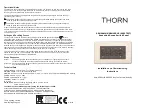
7. I
2
C Interface > Protocol Overview
143
Tsi578 User Manual
June 6, 2016
Integrated Device Technology
www.idt.com
•
CBUS compatibility
— Tsi578 does not provide the DLEN signal
— Tsi578 does not respond as a CBUS device when addressed with the CBUS address. The
Tsi578 will interpret the CBUS address like any other 7-bit address and compare it to its
device address without consideration for any other meaning.
•
Fast Mode or High-Speed Mode (HS-MODE)
•
Reserved 7-bit addresses should not be used as the Tsi578’s 7-bit address. If a reserved address is
programmed, the Tsi578 will respond to that address as though it were any other 7-bit address with
no consideration of any other meaning.
•
10-bit addressing
— Tsi578 must not have its device address programmed to the 10-bit address selection
(11110XXb) in systems that use 10-bit addressing. The Tsi578 will interpret this address like
any other 7-bit address and compare it to its device address without consideration for any
other meaning.
•
General Call. The general call address will be NACK’d and the remainder of the transaction
ignored up to a subsequent Restart or Stop.
7.2
Protocol Overview
The I
2
C protocol is a two-wire serial interface that consists of a bidirectional, open-drain clock bus
(I2C_SCLK), and a bidirectional open-drain data bus (I2C_SD). Multiple master and/or slave devices
can be connected to an I
2
C bus. I
2
C data is transmitted from one device to another across the I2C_SD
bus with timing referenced to the I2C_SCLK bus. With some exceptions, each bus can be driven low
(to a logic 0) by any device, but is pulled high (to a logic 1) by an external resistor tied to VDD. This
creates a “wired-and” configuration, where any single device can drive a bus to a logic 0, but a bus
rises to a logic 1 only if no devices are driving to a logic 0, allowing the pull-up resistor to bring the bus
to a logic 1 voltage.
I
2
C requires one device to assume the role of master during a transfer. The master generates the clock
on the I2C_SCLK bus and controls the overall transfer protocol, as defined by the
I
2
C Specification
.
One or more devices assume the role of slaves during the transfer and respond to the master by either
accepting data from the I2C_SD bus, or providing data to the I2C_SD bus. The selection of a specific
device to act as a slave results from a master transmitting a unique slave address as part of the I
2
C
protocol. Only one device is normally configured with the specific slave address and is the only device
to respond to the master. Other parts of the I
2
C protocol provide for arbitration between multiple
master devices, allowing more than one master device to share the bus on a one-at-a-time basis.
Ti
p
This document refers to I
2
C signals, serial clock and serial data, by names that are defined by
the device package as opposed to the
I
2
C Specification
. For example:
•
Serial clock – Package name is I2C_SCLK, specification name is SCL.
•
Serial data – Package name is I2C_SD, specification name is SDA.
















































